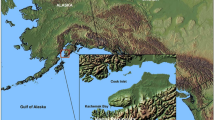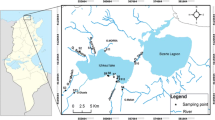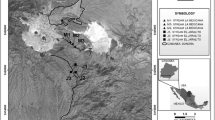Abstract
Total and hexavalent chromium [Cr(VI)] were measured in sediment and sediment porewater in the lower Hackensack River (NJ) to assess the relationship between sediment geochemistry and chromium speciation, which in turn controls the mobility, bioavailability, and toxicity of chromium. Between 2003 and 2005, >100 surface (0 to 15 cm) sediment samples were tested for total chromium and Cr(VI), acid-volatile sulfides (AVS), ferrous iron (Fe(II)), divalent manganese (Mn(II)), ammonia, and organic carbon. Sediment porewater samples were collected by centrifugation or using in situ samplers colocated with the collection of sediments. In whole sediments, total chromium and Cr(VI) concentrations ranged from 5 to 9190 mg/kg dry weight (dw) and from <0.47 to 31 mg/kg dw, respectively. Sediment porewater concentrations ranged from <10 to 83 µg/l for total chromium; Cr(VI) was not detected in sediment porewater (n = 78). Concentrations of AVS (ranging between <10.6 to 4178 mg/kg) and other geochemistry measurements indicated anoxic, reducing conditions in the majority of sediment samples. In polychaetes (Nereis virens) and clams (Macoma nasuta) exposed in the laboratory for 28 days to sediments contained between 135 and 1780 mg/kg dw total chromium, concentrations in whole tissues after 24-hour depuration ranged between 1.2 and 14.8 mg/kg wet weight (ww; median 1.6 mg/kg ww) total chromium. In whole tissues of indigenous polychaetes collected from the sediment, tissue concentrations of total chromium ranged between 1.0 and 37.5 mg/kg ww (median = 2.1 mg/kg ww). Chromium concentrations in whole tissues of animals exposed in the field or in the laboratory showed no relationship with total chromium or Cr(VI) concentrations in the sediment. There were no statistical differences among animals exposed to sediments from site and reference locations. The results of this study are consistent with sediment studies conducted elsewhere indicating low chromium bioavailability in sediment under reducing conditions. This study also highlights the importance of sediment geochemistry and in situ porewater measurements to understand the ecological significance of chromium in sediment and the potential for human health and ecological exposures.



Similar content being viewed by others

References
Allen H, Fu G, Deng B (1993) Analysis of acid-volatile sulfide (AVS) and simultaneously extracted metals (SEM) for the estimation of potential toxicity in aquatic sediments. Environ Toxicol Chem 12:1441–1453
Anderson LD, Kent DB, Davis JA (1994) Batch experiments characterizing the reduction of Cr(VI) using suboxic material from a mildly reducing sand and gravel aquifer. Environ Sci Technol 28:178–185
Barnhart J (1997) Chromium chemistry and implications for environmental fate and toxicity. J Soil Contam 6(6):561–568
Becker DS, Long ER, Proctor DM, Ginn TC (2006) Evaluation of potential toxicity and bioavailability of chromium in sediments associated with chromite ore processing residue. Environ Toxicol Chem 25(10):2576–83
Berry WJ, Boothman WS, Serbst JR, Edwards PA (2004) Predicting the toxicity of chromium in sediments. Environ Toxicol Chem 23(12):2981–92
Besser JM, Brumbaugh WG, Kemble NE, May TW, Ingersoll CG (2004) Effects of sediment characteristics on the toxicity of chromium(III) and chromium(VI) to the amphipod, Hyalella azteca. Environ Sci Technol 38(23):6210–6
Bufflap SE, Allen HE (1995) Comparison of porewater sampling techniques for trace metals. Water Res 29:2051–2054
Burke T, Fagliano J, Goldoft M, Hazen RE, Iglewica R, McKee T (1991) Chromite ore processing residue in Hudson County, New Jersey. Environ Health Perspect 92:131–137
Carr RS, Nipper M (2001) Summary of SETAC technical workshop on porewater toxicity testing: Biological, chemical, and ecological considerations with a review of methods and applications and recommendations for future areas of research. SETAC, Pensacola, FL
Crawford DW, Bonnevie NL, Gillis CA, Wenning RJ (1995) Historical changes in the ecological health of the Newark Bay Estuary, New Jersey. Ecotoxicol Environ Saf 29:276–303
DiGiano FA, Miller CT, Yoon J (1995) Dredging Elutriate Test (DRET) Development Contract Report D-95-1. United States Army Engineer Waterways Experiment Station, Vicksburg, MS
Di Toro DM, Mahony JD, Hansen DJ, Scott KJ, Hicks MB, Mayr SM, et al. (1990) Toxicity of cadmium in sediments: The role of acid volatile sulfide. Environ Toxicol Chem 9:1487–1502
Di Toro DM, Zarba CS, Hansen DJ, Berry WJ, Swartz RC, Cowan CE, et al. (1991) Technical basis for establishing sediment quality criteria for nonionic organic chemicals using equilibrium partitioning. Environ Toxicol Chem 10:1541–1583
Eary LE, Rai D (1987) Kinetics of chromium(III) oxidation to chromium(VI) by reaction with manganese dioxide. Environ Sci Technol 21:1187–1193
Eisler R (1986) Chromium Hazards to fish, wildlife, and invertebrates: A synoptic review. United States Fish and Wildlife Service Biology Report 85(1.6)
ENVIRON (2006) Sediment Remedial Alternatives Analysis Report. Study Area 7, Jersey City, New Jersey. Prepared for Honeywell International, Inc. December 5
Fenchel T (1996) Worm burrows and oxic microniches in marine sediments. 2. Distribution patterns of ciliated protozoa. Mar Biol 127:297–301
Fendorf SE (1995) Surface reactions of chromium in soils and waters. Geoderma 57:65–71
Fendorf SE, Zasoski RJ (1992) Chromium (III) oxidation by δ-MnO2. 1. Characterization. Environ Sci Technol 26:79–85
Forstner V, Whittman GT (1981) Metal pollution in the aquatic environment. Springer-Verlag, Berlin, Germany
Gambrell RP (1994) Trace and toxic metals in wetlands―A review. J Environ Qual 23:883–891
Hall WS, Pulliam GW (1995) An assessment of metals in an estuarine wetlands ecosystem. Arch Environ Contam Toxicol 29:164–173
Hansel CM, Wielinga BW, Fendorf S (2003) Fate and stability of Cr following reduction by microbially generated Fe(II). SSRL (Stanford Synchrotron Radiation Laboratory) Science Highlights, a digital monthly publication. Available at: http://www.ssrl.slac.stanford.edu/research/highlights_archive/cr_contamination.pdf as of 5/29/07
Hesslein RH (1976) An in situ sampler for close interval porewater studies. Limnol Oceanogr 21:912–914
Iannuzzi TJ, Ludwig DF (2004) Historical and current ecology of the lower Passaic River. Urban Habitats 2(1):147–173
Iannuzzi TJ, Huntley SL, Schmidt CW, Finley BL, McNutt RP, Burton SJ (1997) Combined sewer overflows (CSOs) as sources of sediment contamination in the lower Passaic River, New Jersey. I. Priority pollutants and inorganic chemicals. Chemosphere 34:213–231
Icopini GA, Long DT (2002) Speciation of aqueous chromium by use of solid-phase extractions in the field. Environ Sci Technol 36:2994–2996
Integrated Risk Information System (1998) Toxicological review for chromium (VI). Available at: http://www.epa.gov/iris/subst/0144.htm. Accessed: September 2005
James BR, Bartlett RJ (1983) Behavior of chromium in soils: VII. Adsorption and decrease of hexavalent forms. J Environ Qual 12(2):177–181
James BR (2002) Chemical transformations of chromium in soils: Relevance to mobility, bio-availability and remediation. In: The chromium file, no. 8, The International Chromium Development Association. Available at: http://www.chromium-asoc.com/publications/crfile8feb02.htm. Accessed: July 2001
Kahn L (1988) Determination of total organic carbon in sediment. United States Environmental Protection Agency, Region II, Environmental Services Division, Monitoring Management Branch, Edison, NJ
Kozuh N, Stupar J, Gorenc B (2000) Reduction and oxidation processes of chromium in soils. Environ Sci Technol 34:112–119
Kraus ML (1989) Bioaccumulation of heavy metals in prefledgling tree swallows, Tachycineta bicolor. Bull Environ Contam Toxicol 43:407–414
Lin C-J (2002) The chemical transformations of chromium in natural waters―A model study. Water Air Soil Pollut 139:137–158
Lin CH, Pedersen JA, Suffet IH (2003) Influence of aeration on hydrophobic organic contaminant distribution and diffusive flux in estuarine sediments. Chemosphere 37(16):3547–3554
Long ER, MacDonald DD, Smith SL, Calder FD (1995) Incidence of adverse biological effects within ranges of chemical concentrations in marine and estuarine sediments. Environ Manage 19(1):81–97
Luther GW, Brendel PJ, Lewis BL, Sundby B, Lefrancois L, Silverberg N, et al. (1998) Simultaneous measurement of O2, Mn, Fe, I-, and S(-II) in marine porewaters with a solid-state voltammetric microelectrode. Limnol Oceanogr 43:325–333
Masscheleyn PH, Pardue JH, DeLaune RD, Patrick Jr WH (1992) Chromium redox chemistry in a lower Mississippi Valley bottomland hardwood wetland. Environ Sci Technol 26(6):1217–1226
Milačič R, Štupar J (1995) Fractionation and oxidation of chromium in tannery waste-and sewage sludge-amended soils. Environ Sci Technol 29:506–514
National Oceanic and Atmospheric Administration (2003) Watershed database for Newark Bay, Coastal Protection and Restoration Division. Available at: http://www.response.restoration.noaa.gov/cpr/watershed/watershedtools.html. Accessed: August 2006
New Jersey Department of Environmental Protection (1998) Guidance for sediment quality evaluations. Site Remediation Program, Trenton, NJ
Norwood WP, Borgmann U, Dixon DG (2006) Saturation models of arsenic, cobalt, chromium and manganese bioaccumulation by Hyalella azteca. Environ Pollut 143:519–528
Paul JF, Comeleo RL, Copeland J (2002) Landscape metrics and estuarine sediment contamination in the mid-Atlantic and southern New England regions. J Environ Qual 31:836–45
Peternac B, Legovic T (1986) Uptake, distribution and loss of chromium in the crab Xantho hydrophilus. Mar Biol 91:467–471
Peterson GS, Ankley GT, Leonard EN (1996) Effect of bioturbation on metal-sulfide oxidation in surficial freshwater sediments. Environ Toxicol Chem 15(12):2147–2155
Rai D, Sass BM, Moore DA (1987) Chromium(III) hydrolysis constants and solubility of chromium(III) hydroxide. Inorganic Chem 26:345–349
Rice KC (1999) Trace-element concentrations in streambed sediment across the conterminous United States. Environ Sci Technol 33:2499–2504
Richard FC, Bourg ACM (1991) Aqueous geochemistry of Cr: A review. Water Res 25(7):807–816
Rhoads DC, Germano JD (1982) Characterization of benthic processes using sediment profile imaging: An efficient method of remote ecological monitoring the seafloor (REMOTS™ System). Mar Ecol Prog Ser 8:115–128
Rozan TF, Taillefert M, Trouwborst RE, Glazer BT, Ma SF, Herszage J, et al. (2002) Iron-sulfur-phosphorous cycling in the sediments of a shallow coastal bay: Implications for sediment nutrient release and benthic macroalgal blooms. Limnol Ocean 47(5):1346–1354
Saleh FY, Parkerton TF, Lewis RV, Huang JH, Dickson KL (1989) Kinetics of chromium transformations in the environment. Sci Total Environ 86(1–2):25–41
Sass BM, Rai D (1987) Solubility of amorphous chromium (III)-iron(III) solid solution. Inorg Chem 26:2228–2232
Schmieman EA, Yonge DR, Rege MA, Petersen JN, Turick CE, Johnstone DL, et al. (1998) Comparative kinetics of bacterial reduction of chromium. J Environ Eng 124:449–455
Schroeder DC, Lee GF (1975) Potential transformations of chromium in natural waters. Water Air Soil Pollut 4:355–365
Serbst JR, Burgess RM, Kuhn A, Edwards PA, Cantwell MG, Pelletier MC, et al. (2003) Precision of dialysis (peeper) sampling cadmium in marine sediment interstitial water. Arch Environ Contam Toxicol 45(3):297–305
Sorensen MT, Conder JM, Fuchsman PC, Martello LB, Wenning RJ (2007) Using a sediment quality triad approach to evaluate benthic toxicity in the lower Hackensack River, New Jersey. Arch Environ Contam Toxicol 53:36–49
Sprague JB (1985) Factors that modify toxicity. In: Rand GM, Petrocelli SR (eds) Fundamentals of aquatic toxicology. Hemisphere, Washington, DC, pp 124–163
Stanin FT (2005) The transport and fate of chromium (VI) in the environment. In: Guertin J, Jacobs JA, Avakian CP (eds) Chromium (VI) handbook. CRC, Boca Raton, FL, pp 165–199
Stollenwerk KG, Grove DB (1985) Adsorption and desorption of hexavalent chromium in an alluvial aquifer. J Environ Qual 14:150–155
Thamdrup B, Fossing H, Barker Jorgensen B (1994) Manganese, iron and sulfur cycling in a coastal marine sediment, Aarhus Bay, Denmark. Geochim Cosmochim Acta 58(23):5115–5129
Tzou YM, Loeppert RH, Wang MK (2002) Effect of organic complexing ligands on Cr(III) oxidation by MnOx. Soil Sci 167(11):729–738
United States Environmental Protection Agency (1984) Ambient water quality criteria for chromium. EPA 440/5-84-029. Washington, DC
United States Environmental Protection Agency (1993) Guidance manual: Bedded sediment bioaccumulation tests. EPA/600/R-93/183. Washington, DC
United States Environmental Protection Agency (2003a) A compendium of chemical, physical, and biological methods for assessing and monitoring the remediation of contaminated sediment sites. EPA/600/R-03/108. Washington, DC
United States Environmental Protection Agency (2003b) Procedures for the derivation of equilibrium partitioning sediment benchmarks (ESBs) for the protection of benthic organisms: Polycyclic aromatic hydrocarbon mixtures. EPA-600-R-02-013. Washington, DC
United States Environmental Protection Agency (2004) Sewer sediment and control. Office of Research and Development, Edison, NJ. Available at: http://www.epa.gov/ORD/NRMRL/pubs/600r04059/600r04059.pdf. Accessed: March 2006
United States Environmental Protection Agency (2005a) Contaminated sediment remediation guidance for hazardous waste sites. Office of Solid Waste and Emergency Response. Revised Version. OSWER 9355.0-85. EPA/540/R-05/012. December. Available at: http://www.epa.gov/superfund/resources/sediment/guidance.htm
United States Environmental Protection Agency (2005b) Procedures for the derivation of equilibrium partitioning sediment benchmarks (ESBs) for the protection of benthic organisms: Metal mixtures (cadmium, copper, lead, nickel, silver and zinc). Appendix D: Chromium. EPA/600/R-02/011. Washington, DC. Available at: http://www.epa.gov/nheerl/publications/files/metalsESB_022405.pdf
United States Environmental Protection Agency and United States Army Corps of Engineers (1991) Evaluation of dredged material proposed for ocean disposal: Testing manual. EPA 503/8-91/001. Washington, DC
United States Environmental Protection Agency and United States Army Corps of Engineers (1998) Evaluation of dredged material proposed for discharge in waters of the United States―Inland testing manual. EPA/823/B-98/004. Office of Water, Washington, DC. Available at: http://www.epa.gov/nheerl/publications/files/metalsESB_022405.pdf
Valente RM, Rhoads DC, Germano JD, Cabelli VJ (1992) Mapping benthic enrichment patterns in Narragansett Bay, RI. Estuaries 15:1–17
Walsh AR, O’Halloran J (1996) Chromium speciation in tannery effluent. I. An assessment of techniques and the role of organic Cr(III) complexes. Water Res 30:2393–2400
Weaver RM, Hochella MF (2003) The reactivity of seven Mn-oxides with Cr3+aq: A comparative analysis of a complex, environmentally important redox reaction. Am Mineralogist 88:2016–2027
Wu Y, Deng B, Xu H, Kornishi H (2005) Chromium (III) oxidation coupled with microbially mediated Mn(II) oxidation. Geomicrobiology J 22:161–170
Zatka VJ (1985) Speciation of hexavalent chromium in welding fumes. Interference by air oxidation of chromium. Am Ind Hygiene Assoc J 46(6):327–331
Acknowledgments
Funding for this study was provided by Honeywell International. Ocean Surveys (Old Saybrook, CT) and HydroQual (Mahwah, NJ) assisted with the collection of sediments, porewater, and biota, as well as design and deployment of the in situ porewater samplers. The authors also wish to acknowledge T. Barber for critical analysis of the study design, K. Leigh for technical assistance, and two anonymous reviewers for their constructive comments.
Author information
Authors and Affiliations
Corresponding author
Rights and permissions
About this article
Cite this article
Martello, L., Fuchsman, P., Sorensen, M. et al. Chromium Geochemistry and Bioaccumulation in Sediments from the Lower Hackensack River, New Jersey. Arch Environ Contam Toxicol 53, 337–350 (2007). https://doi.org/10.1007/s00244-006-0164-6
Received:
Accepted:
Published:
Issue Date:
DOI: https://doi.org/10.1007/s00244-006-0164-6



